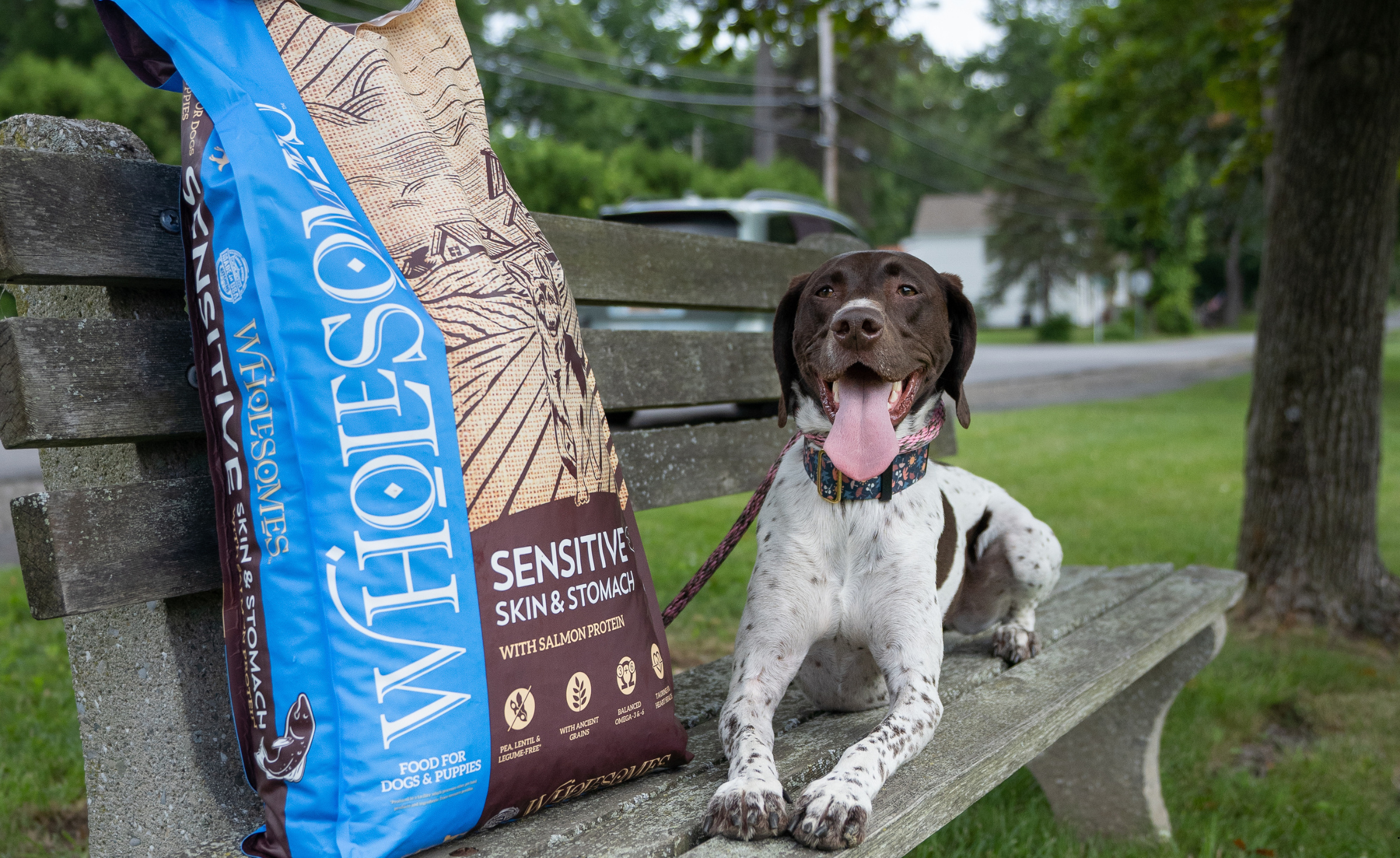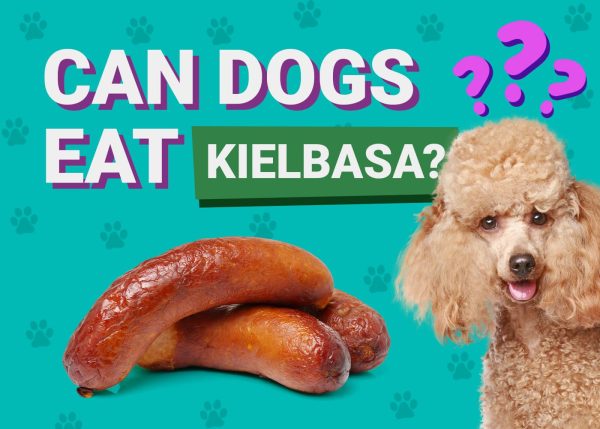In this article
When we see our pet is uncomfortable due to incessant scratching or chewing, we know it’s time to seek help. Unfortunately, where to start on your dog’s journey to healthy skin and gut can be overwhelming. That’s why Wholesomes has created special kibble recipes for dogs dealing with skin and stomach sensitivities. This guide will help you identify the warning signs, implement a strategy, and find nutrition solutions to support your dog’s sensitivities.

Food Allergen vs. Food Intolerance
Allergens are substances that cause an allergic reaction. A food intolerance in dogs is an inability to consume food without adverse effects. The significant difference between dog food allergies and food intolerances is the involvement of the immune system.
When Food Allergies Occur
Food allergies occur when the dog’s immune system mistakenly identifies a harmless ingredient as a threat. Thus, triggering an immune response which can lead to various symptoms of dog food allergies, including:
- Internal and external inflammation
- Itchy skin and paws
- Gastrointestinal issues such as diarrhea or vomiting
- Chronic ear infection
Food allergens are often associated with the type of protein in the diet. However, some allergens may be due to other dietary components, such as a carbohydrate or fat source.
When Food Intolerances Occur
Food intolerance, on the other hand, does not involve the immune system. Instead, they occur when a dog’s digestive system cannot properly process certain ingredients. Dog food intolerance symptoms are often observed via different gastrointestinal upsets, such as:
- Bloating and gas
- Diarrhea
- Vomiting
- General abdominal discomfort
A food intolerance is not solely associated with the dietary protein source. It may occur due to other ingredients, such as additives and select carbohydrates.
Whether your dog has a food allergy or intolerance, switching to a food that caters to their sensitivities may help resolve the problem.
The Skin and Stomach Connection
Your dog’s stomach and skin are connected more than you may think, with scientists calling this connection the “gut-skin axis.” When poor-quality food, allergens, or food intolerances upset your dog’s digestive system, their skin is often the first sign that there is an issue. That’s why dogs with digestive issues frequently have itchy, irritated skin issues at the same time.
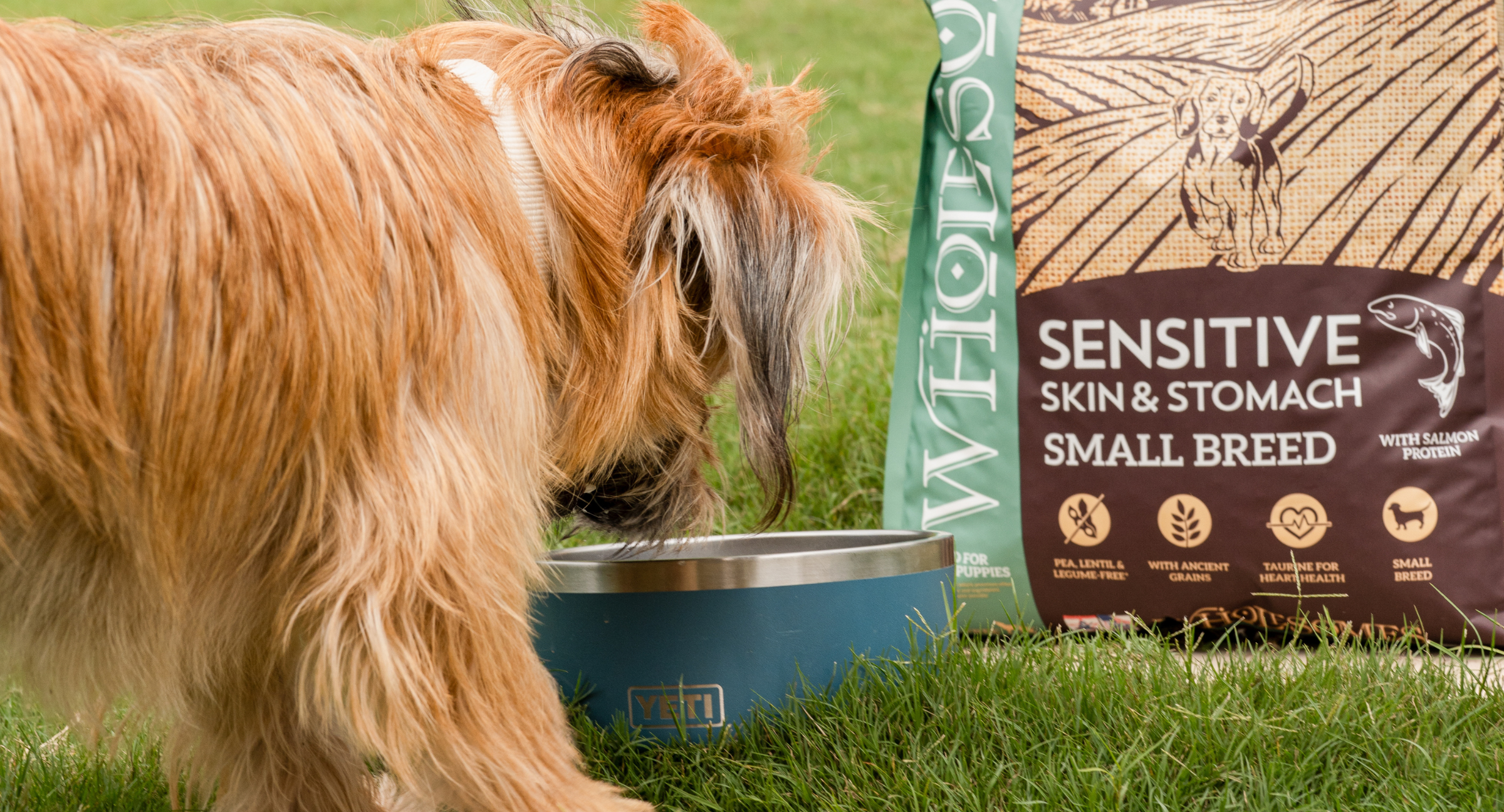
The microbiome within your dog’s gut plays a significant role in the connection between the skin and stomach. Research shows that healthy dogs have different gut microbiome bacteria than dogs with skin issues. A balanced gut microbiome supports your dog’s immune system, which is essential for healthy skin.
Since a dog’s skin is the largest organ of the body, it can make up 12 to 24% of their total weight, depending on age and breed. The skin and coat of your dog are more than a barrier to protect against the environment and support temperature regulation. It also serves as the soft, silky outer layer you love to snuggle and pet, making it that much more noticeable when skin issues occur.
Long-term Effects of Ignoring Sensitivities
Unfortunately, food allergies and intolerances, better known as food sensitivity, do not go away on their own. When visual symptoms, such as scratching, persist, it indicates that an internal inflammatory response is also ongoing.
This inflammation may damage your dog’s intestinal barrier, causing “leaky gut syndrome”. Leaky gut syndrome causes more allergens to enter the bloodstream. This makes skin reactions worse, and the cycle continues.
A compromised immune system due to food sensitivities can lead to other health issues beyond itchy skin or paws. A weakened immune system means your dog is more likely to get an infection and become sick. It also slows down wound healing and recovery after injury or surgery. With proper nutrition and the removal of food sensitivities from your dog’s diet, you can help minimize the long-term effects.
Spotting the Signs Your Dog Needs Help
Sadly, our pets cannot tell us when something is wrong. Instead, they rely on showing us. Catching these warning signs early may save your pet from months of discomfort or a lifetime of issues.
Below is a list of behaviors and physical symptoms your dog may display if they are experiencing food sensitivities.
Constant scratching and hair loss
Excessive scratching is usually the first sign that something’s not right with your dog’s digestive system. Your dog might focus on the same spots over and over—around their tail, back, or thighs. This persistent scratching often leads to patchy bald spots, scaly or flaky skin, and visible hair loss.
Dogs experiencing food sensitivities may develop dry, flaky skin that often looks red and is sore to the touch. The constant scratching from an immune response leads to another immune response. This creates a cycle that repeats itself. This cycle often leaves your dog’s skin more susceptible to skin infections.
One of the best dog foods for sensitive skin is Wholesomes Sensitive Skin & Stomach Salmon Protein recipe. The salmon protein in this recipe is easy to digest and promotes a soft, shiny coat. This is due to its natural omega-3 fatty acids that fight inflammation and soothe dry, itchy skin.
It also includes easy-to-digest carbohydrates and high-quality fiber sources. Plus, it is packed with essential vitamins like D and B-complex to boost immune function.
Digestive upset that won’t go away
Gastrointestinal issues related to digestion show different symptoms from skin problems. However, they are just as important to monitor.
Symptoms of an upset stomach in dogs can be seen in various forms. The most common forms are loose stool or diarrhea for more than 24 hours. Additionally, excessive gas, especially when your dog seems uncomfortable or bloated, deserves immediate attention.
Vomiting several times a day or within a week is also not normal for digestive processes. This may be the biggest red flag that something isn’t right within their digestive system. Experiencing skin and stomach issues simultaneously usually points to food sensitivities rather than other causes. Failure to properly address these issues could lead to long-term problems within the gastrointestinal tract.
Ear infections and hot spots
Ear infections may be another indicator of food sensitivity occurring. Common signs of an ear infection are:
- head shaking,
- ear scratching,
- and/or in combination with smelly discharge.
Additionally, the ear infections continue to return until the cause is addressed.
Another warning sign of a food sensitivity is hot spots. Hot spots are painful, red, wet patches that appear quickly when dogs lick and chew at irritated skin. These hot spots create ideal conditions for bacterial growth.
If your dog has an immune response along with this bacterial growth, it may struggle to heal. The hot spots might keep coming back until you address the food sensitivity.
When to call your vet
Contact your veterinarian right away if you see multiple symptoms at once. Witnessing blood in the vomit or stool, along with clear signs of bloating, requires immediate attention. Do not wait to contact the vet if your dog:
- is fatigued,
- is not eating food,
- appears to be in pain,
- and/or has symptoms that last more than 48 hours.
An office visit will likely be required to rule out parasites, infections, and other medical conditions before focusing on food sensitivities. Once the vet has identified the issues as food-related, specialized sensitive recipes can provide the targeted support your dog needs to recover and heal.

What Makes a Good Sensitive Skin & Stomach Dog Food
Finding the right food for your dog’s sensitivities and nutritional needs can be daunting, but it doesn’t have to be. Below, we provide guidelines about how to find the best dog food for sensitive stomachs and skin.
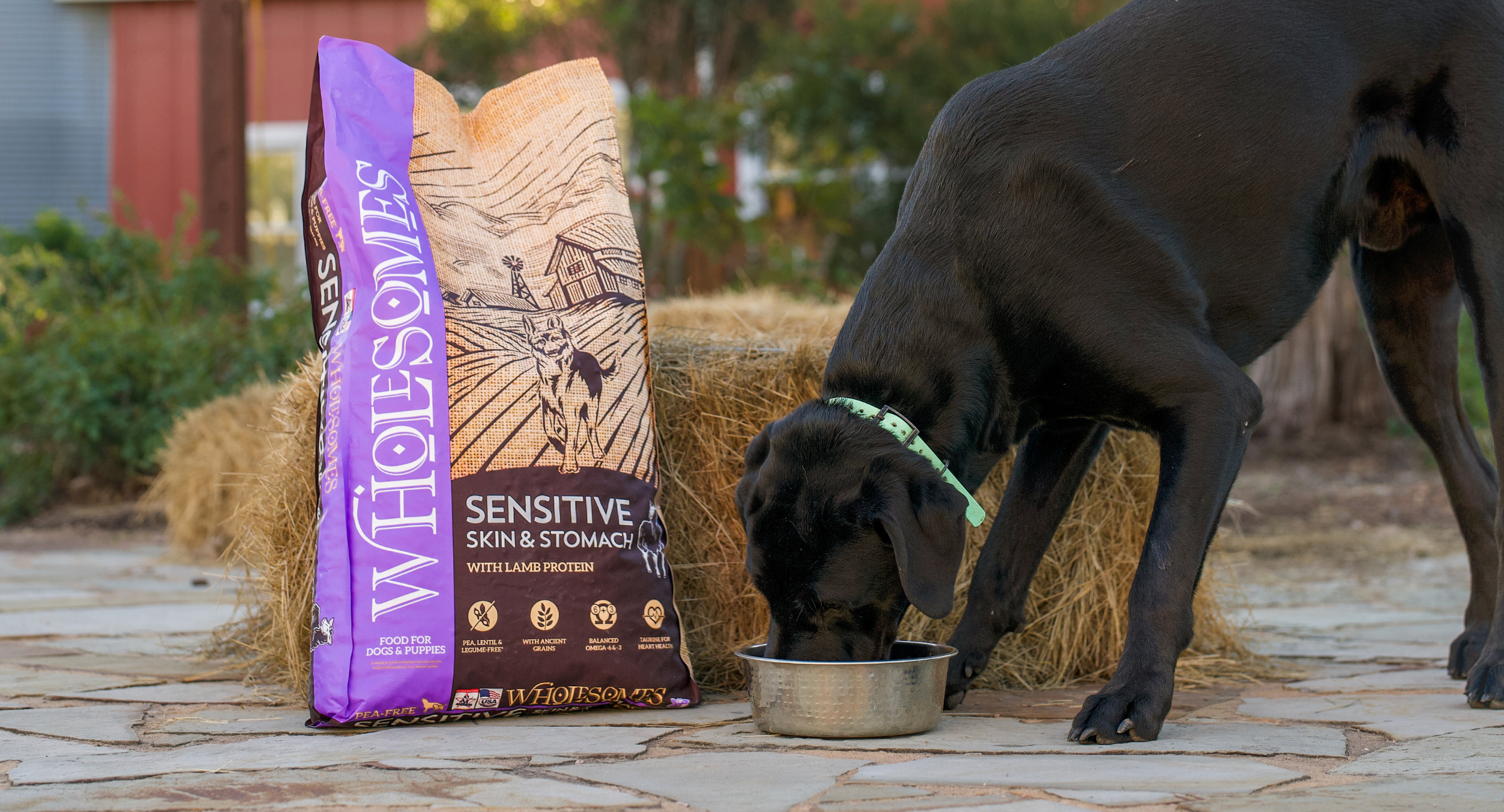
Key ingredients to look for:
Protein:
Start with easily digestible proteins. Easily digestible proteins, such as lamb or salmon, help minimize allergic reactions and protein intolerances. Allowing your dog’s digestive system to break down and utilize these protein sources better than other proteins.
Carbohydrates:
Look for quality carbohydrates such as rice and properly processed potatoes to provide a gentle-to-digest energy source. These ingredients are easily digested and lead to fewer digestive upsets than other carbohydrate sources, such as modern grains.
Fiber:
Fiber plays a significant role in healthy digestive processes as well. Ingredients like dried beet pulp and flaxseed promote more regular digestion. The right balance of soluble and insoluble fiber keeps everything moving smoothly through the digestive system.
This is why Wholesomes Sensitive Skin & Stomach recipes are great food for dogs with general food sensitivities. These recipes are crafted with easily digestible proteins and carbohydrates, along with quality fiber sources. Wholesomes Sensitive Lamb or Salmon recipes support healthy digestion for puppies and adult dogs alike and are enhanced with omega fatty acids to keep skin and coat looking their best.
Avoiding common allergens and intolerances
Some ingredients cause more digestive problems than others. Research shows beef, dairy, chicken, and egg-based ingredients rank among the most frequent allergens in dogs, with certain breeds, such as boxers, labs, pugs, and retrievers, having higher rates of food allergies.
Skip foods that contain increased levels of:
- Corn and soy
- Artificial additives and preservatives
- Low-quality ingredients that offer little nutrition
Benefits of omega-3s and vitamins
Omega-3 fatty acids are known for their anti-inflammatory properties. They support skin health by reducing inflammation caused by food sensitivities. Overall skin health can improve with supplementation, while also reducing issues like itchiness and flaking. Fish oil supplements are a proven and effective ingredient that improves overall skin and coat health while reducing itchiness.
Why digestibility matters most
Here’s what really counts – how much nutrition your dog actually absorbs from their food. High-quality dog foods typically exceed 82% digestibility for dogs.
Dogs with food sensitivities often have trouble digesting some ingredients. It is important to feed them recipes that are easy to digest. This helps reduce digestive stress and makes sure they get the nutrients they need.
When your dog can more easily digest their food without an immune response, it means they are getting more nutrition out of every bite. Better nutrition and nutrient absorption mean better health from the inside out.

Why Switch To Sensitive Dog Food?
Finding the best food for dogs with food allergies or intolerances doesn’t have to be hard. You have now learned how closely linked your pet’s stomach and skin are. You also know that a dog’s food sensitivities often improve with the right nutrition.
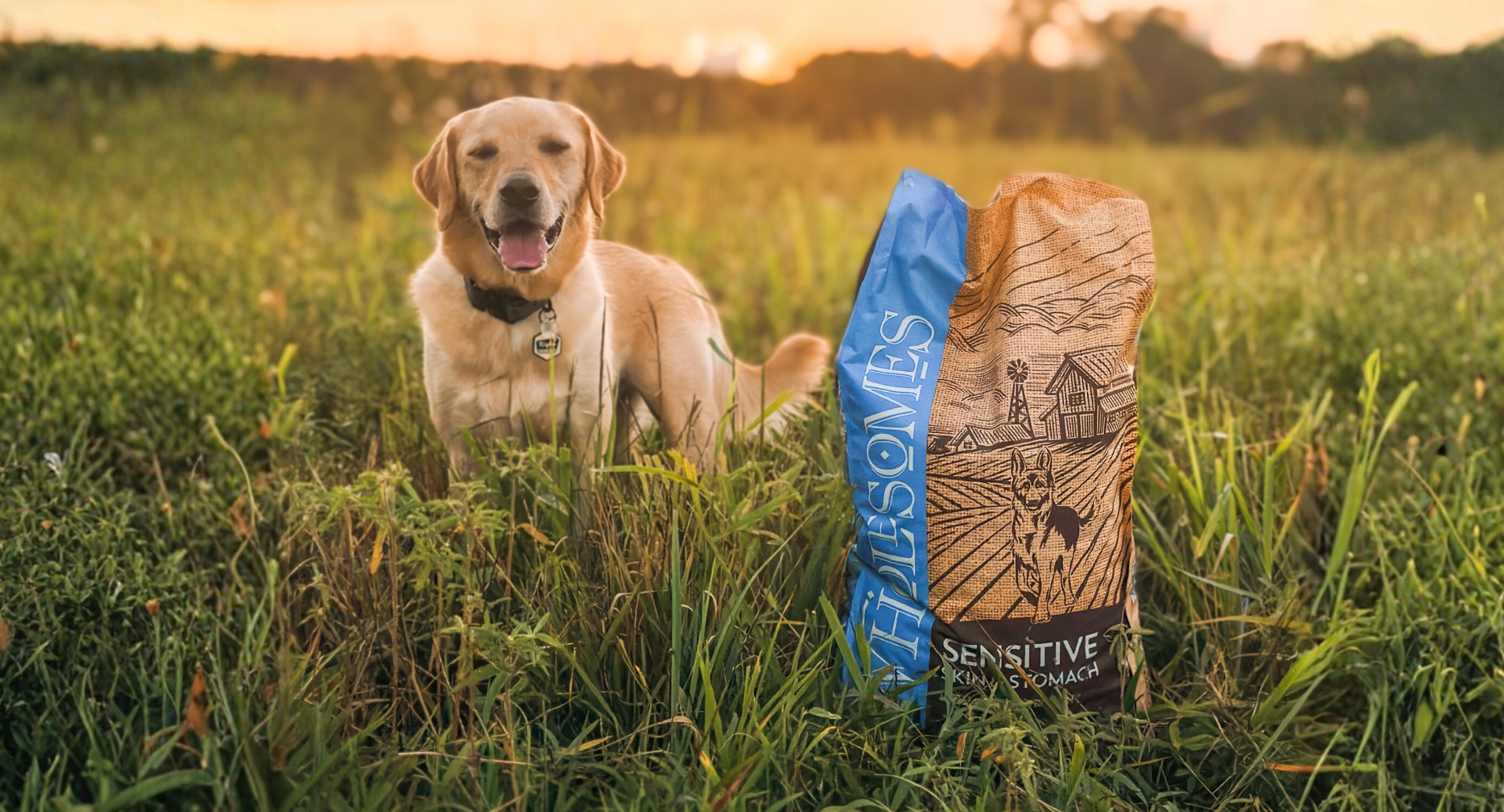
Switching to food made for sensitive dogs can change your dog’s whole life. The best sensitive skin and stomach diet tackles the real problem, not just the symptoms. Wholesomes Sensitive recipes have a solution for every dog. For example:
- Lamb Protein for balanced support
- Salmon Protein for skin health
- Large Breed for bigger pups
- Small Breed for little ones
These recipes skip common allergens while adding nutrients that help both skin and digestion. They are packed with easily digestible proteins, carbohydrates, and fiber sources, along with omega-3s. Every ingredient works together to calm inflammation, restore balance, and provide your dog with a better quality of life.
How to switch to dog food gradually?
Take it slow when changing foods. Mix increasing amounts of your new dry dog food with decreasing amounts of your current food over 7-10 days. This gentle approach prevents further upset of the digestive system during the diet transition.
Why Choose Wholesomes?
Your pet deserves nutrition that helps them thrive. At Wholesomes, we’ve spent 4 generations crafting trusted, high-quality food and treats for pets just like yours.
Proudly made in family-owned kitchens with nearly a century of experience. Our rigorous testing ensures your dog gets safe, high-quality food in every bowl. Plus, a portion of all purchases helps the Children of Fallen Patriots Foundation.
Images by © 2025 Wholesomes™ All rights reserved.
